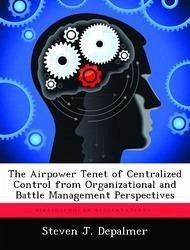This study examines the airpower tenet of centralized control, which US Air Force doctrine has traditionally upheld as the foundation for organizing, planning, and executing joint air operations. The tenet is examined from both an organizational and a battle management aspect. The organizational aspect refers to the command and procedural arrangements that permit a Joint Forces Air Component Commander (JFACC) to achieve unity of air effort. It is the JFACC's span of control. The battle management aspect refers to the JFACC's actions in the process of planning and executing theater air operations. It is the JFACC's level of control. Most doctrinal publications that mention JFACC operations focus on the organizational aspect, and not the battle management aspect of the tenet of centralized control.first covers the evolution of the air component commander's span of control, which prior to the Goldwater-Nichols Act of 1986 rarely permitted unity of air effort. Next it examines the JFACC levels of control exercised in Operations DESERT STORM and DELIBERATE FORCE and looks at six factors that either instigated or facilitated these different levels of control.
Hinweis: Dieser Artikel kann nur an eine deutsche Lieferadresse ausgeliefert werden.
Hinweis: Dieser Artikel kann nur an eine deutsche Lieferadresse ausgeliefert werden.








